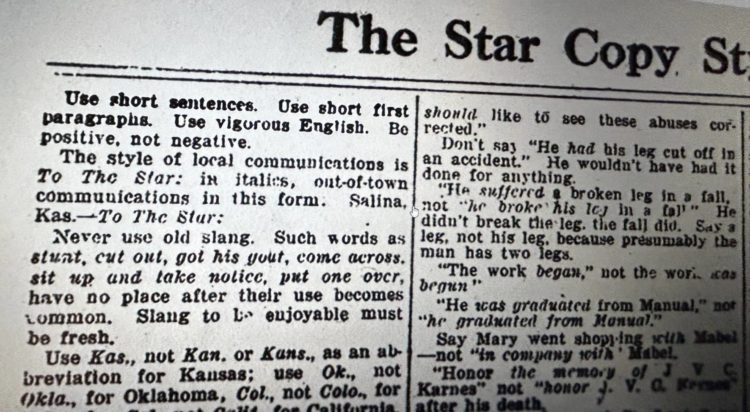
Column – On my watch
By Anne W. Semmes
So, today is Ernest Hemingway’s birthday, born 124 years ago on July 21, 1899. So, what should pop up recently on PBS was a rerun of Ken Burn’s six-hour documentary on Hemingway. And in the first episode I was riveted by a closeup shot in the Kansas City Star newspaper, where Ernest began his writing career at age 17 in 1917. The close-up showed: “The Star Copy Style” of which Ernest had been instructed that would help to shape his writing leading one day to the Nobel Prize of Literature!
That Copy Style began with: “Use short sentences. Use short first paragraphs. Use vigorous English. Be positive, not negative…” That Kansas City “Star Copy Style,” which is quite lengthy, is now famous, worth a read, and available online with an introduction and photo of Hemingway. It reads, “Hemingway later remarked …that the admonitions in this style sheet were “the best rules I ever learned in the business of writing.”
In his seven months at the Star covering the police and emergency-room items, he was given no byline. It was after his WWI injury episode that Ernest began working for the Toronto Star newspaper in 1920 that not only gave him a byline but would give him “the keys to the world” when the Star assigned him its correspondent in Europe – age 22. He would continue with the Star until 1924. Towards the end he had reportedly pinned up on the Star office bulletin board “a scroll of grievances and denunciations…that trailed almost to the floor,” now lost, but he kept his Star clippings the rest of his life.
So, seeing that Ken Burns episode reminded me of that extraordinary gift I was given years ago by friend Jay Tunney of full-size copies of the Toronto Star newspapers dating from 1920-1922 that include Hemingway’s stories. Where had I stored them? Found they were and then the reading began again of his stories of which I will share a few.
Hemingway’s kickoff of “news-you-can-use”
So, the first that grabbed was “Fishing For Trout In A Sporting Way” (April 1920). Definitely not the length recommended to me by a New York Times editor years ago who ruled, “There’s not a story that can’t be told in 600 words or less.” Hemingway’s Trout fishing how-to was thousands of words with subheads of “Worms in Coffee Grounds” and “Grasshopper Bait.” Equally long was “When You Camp Out Do It Right,” from June 1920, with subheads of “Old Quilt Handy” and “How to Make Pie.” He begins with “Thousands of people will go into the bush this summer to cut the high cost of living…” A sequel follows in August, “When You Go Camping Take Lots of Skeeter Dope and Don’t Ever Lose It.” Its subtitle: “And Take Cheese Cloth Instead of Mosquito Netting – Without These Things Friends May Get to Hating Each Other.”
What Hemingway is doing here, repeatedly, is pioneering news-you-can-use! As in the April 1921 feature, “Toothpulling Not a Cure-For-All,” with subtitle, “All Those Possible Should Be Saved is the Proper Course.” “To the mind of the man in the street the practice of medicine is swayed by a series of fads.”
Hemingway’s humor abounds in a short feature from August of 1921, “Condensing the Classics.” He begins, “There are a little group of earnest condensers, said to be endowed by Andrew Carnegie, who have been laboring for the last five years at reducing the literature of the world into palatable morsels for the tired businessman’s consumption.” He suggests rather than cutting Les Misérables to 10 pages, etc. to reduce all literature to newspaper headlines, with a short news dispatch following… “Take Don Quixote for example: ‘Crazed Knight in Weird Kilt.’”
He jumps to headlining William Blake, dateline India…“Big Cat in Flames.” Blake, he writes is reportedly lost in the jungle and when found delirious cites “Tiger, tiger burning bright in the forest of the night.” “Then there’s Coleridge: ‘Albatross Slayer Flays Prohibition’… ‘Ancient’ Mariner in Bitter Assault on Bone Dry Enforcement.’”
Impossible to give the full humor here without including all the copy.
Hemingway’s European Reporting
That humor is astonishingly also found in Hemingway’s supposedly serious reporting from Europe in 1922. Beneath his February headline of “France Now in Hands of Old Professional,” he writes, “Canadian interest in European politics is as dead as a bucket of ashes.”
Another headline says it all: “Queer Mixture of Aristocrats, Profiteers, Sheep And Wolves at the Hotels in Switzerland.” Another headlines “Wives Buy Clothes for French Husbands.” One of his male interviewees laments, “I am clothed in bargains. What matter if they do not fit? They are bon marche. Still, she is a wonderful cook.”
Attending the World Economic Conference in Genoa, Italy, with some 34 nations represented, Hemingway is bewitched by “Two Russian Girls The Best Looking at Genoa Parley” as his headline reads. He describes the many delegates entering the great hall of the Pallazo San Giorgio. Finally, the Russian delegates arrive followed by a “mass of secretaries…including two girls with fresh faces, hair bobbed in the fashion started by Irene Castle and modish tailored suits. They are far and away the best-looking girls in the conference hall.” Then “the dreary round of speeches” begin as he ends.
He also points a finger in his headline to the “German Journalists a Strange Collection – All Wear Knickers.” He begins, “If it is true that the funnier looking a newspaper man is the better work he does, there were some world beaters at the Genoa conference.”
But earlier that year in Spain, Hemingway was truly in his element. His headline? “At Vigo, in Spain, is Where You Catch the Silver and Blue Tuna, the King of All Fish.” “If you land a big tuna after a six-hour fight, fight him man against fish when your muscles are nauseated with the unceasing strain, and finally bring him up alongside the boat, green-blue and silver in the lazy ocean, you will be purified and be able to enter unabashed into the presence of the very elder gods and they will make you welcome.”
Hemingway was truly on his way in more ways than one to his Nobel Prize.






